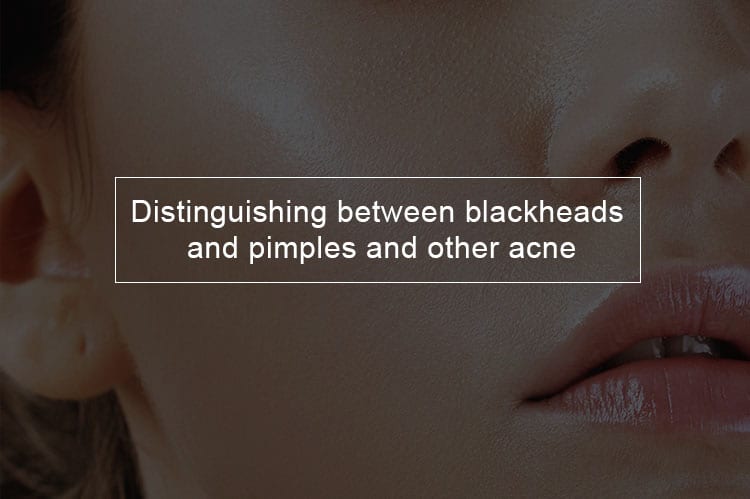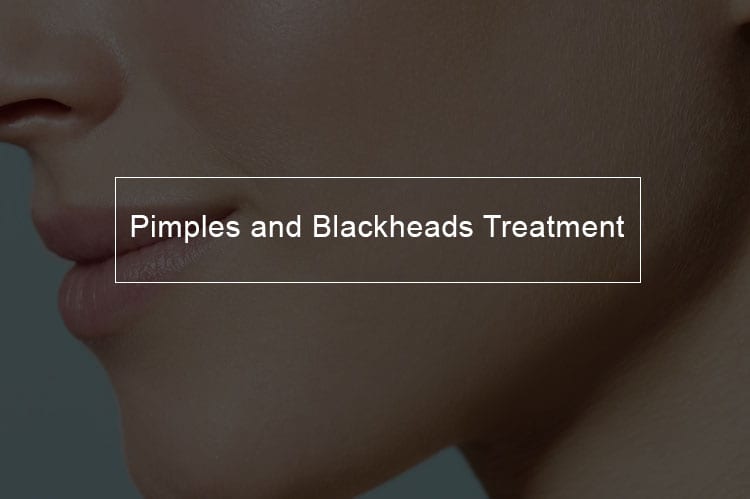
Blackheads and pimples are both types of acne blemishes. However, they are different from each other. They form in different ways, have a different look and are dealt with differently as well. Pimples are red and inflamed with a white or red tip. Blackheads have a black or brown tip and they are not inflamed.
The difference in inflammation between pimples and blackheads
Pimples are red and inflamed
Pimples are inflamed acne. They are red and swollen. They can be painful, however, not all the time. Some pimples remain small, but others can get relatively large. They usually appear on the face, shoulders, neck and even on the butt.
Blackheads are not inflamed
Blackheads are non-inflamed acne. They are not swollen, usually just flat, they are not red or inflamed, and usually not painful. In fact, if you don't look at the mirror, you might not know that you have a blackhead. You can get blackheads in the same places pimples appear; however they're most common on the nose, chin, around the ears and lip area. Some blackheads can get rather big and obvious, while others are so small you can hardly see them with the naked eye.
The difference in color between a pimple and a blackhead
Pimples have a red or white tip or head
There are different types of pimples. A pimple with a red head or bump is called an acne papule. With time, the papule may develop a yellow or white top filled with pus. If this happens, then it's now called an acne pustule. However, not all papules develop into pustules. Pustules are often called milia or whiteheads. Even though they share a name, pustules and milia are entirely different kinds of blemishes. In truth, there are several skin issues that trigger a white tip or head. But if your bump is red, inflamed, with a white head, that is an acne pustule.
Blackheads have a black or dark brown head
Blackheads have a dark blackish-looking head, and that is where the name comes from. Some blackheads appear more brown than black. Blackheads look like a well-defined dark dot on the skin. Some blackheads are incredibly tiny, so small you can hardly see them with naked eyes. Other blackheads can get rather large, several millimeters in diameter. A blackhead is technically referred to as an open comedo.
How pimples develop?
Pimples form when a plug of oil and dead skin cells become trapped in the skin pore. This plug blocks the pore. The sebaceous glands, on the other hand, continue to secrete sebum for your skin regardless of the blocked pore. The oil is still pumped into the pore but will not be able to flow up and out. The oil ends up being stuck in the pore with nowhere to escape. All this commotion added together with the skin bacteria such as Propionibacteria acnes, and the roots end up being inflamed and engorged. With no place else to go, this glut of oil, bacteria, and skin cells, swells and causes the follicle wall to break. This cues the white blood cells to rush on the scene and the pore ends up being red and inflamed.
How blackheads develop?
Just like in pimples, blackheads form when the pores are clogged. However, with blackheads, the clog develops at the skin's surface and not deeper within the pore. The black tip of the blackhead is not trapped dirt; it is the plug of sebum. The top of the plug oxidizes since it's exposed to air, and turns into that dark blackish-brown spot you see. Blackheads normally don't become red and swollen since they hardly ever cause a break in the hair follicle wall.
Treatment for Pimples and Blackheads

How to treat pimples?
There are various drugs and products out there that can help you deal with your pimple issues. For small breakouts, over-the-counter acne medications should suffice. More stubborn or extensive acne can be treated with prescription acne medications that you get from your doctor.
The most popular treatments for inflamed breakouts
- Topical retinoids
- Topical antibiotics and oral antibiotics
- Benzoyl peroxide
- Birth control pills and isotretinoin (for females only)
Remember, do not pop inflamed pimples. This will only trigger scars and won't do any good when it comes to recovery.
How to treat blackheads?
Since blackheads are not as deep as pimples, they can be squeezed. But it has to be very carefully done. It is possible to do it yourself; however, it is recommended to let an expert do it for you, maybe during a facial. Pore strips are another method to deal with blackheads. Using this method yields temporary results. Pore strips only get the head out and leave behind the rest of the comedone. This will eventually grow back to a new blackhead very quickly. This technique is, however, useful when you want instant results ahead of a big event, date, or a public appearance. For more permanent results, a routine treatment program is advisable. Once again, moderate blackheads can be treated with over-the-counter products. If you have lots of blackheads and rough skin, you have a kind of non-inflamed acne called comedonal acne. Prescription medications are best to treat more established comedonal acne.
Choices for dealing with blackheads
- Salicylic acid
- Topical retinoids
- Benzoyl peroxide
- Alpha hydroxy acids, including lactic acid, mandelic acid, and glycolic acid
Other common types of acne
Acne can lead to many different types of skin blemishes, each with unique looks and symptoms. They can be divided into inflammatory and non-inflammatory acne.
Types of non-inflammatory acne
As discussed, blackheads fall under the non-inflammatory group of acne. They are also joined with whiteheads in this group. Whiteheads are medically known as closed comedones. They are small bumps or spots that have a white tip surrounded by a red ring. They can grow big but usually do not cause any scarring. Non-inflammatory acne is usually the least troublesome as they do not cause any swelling and are not uncomfortable.
Types of inflammatory acne
Inflammatory acne blemish are as follows:
- papules
- pustules
- nodules
- cysts
Inflammatory acne is more serious than noninflammatory acne, and this type is most likely to cause complications, such as pitting or scarring. This type of acne causes lesions or blemishes that are red, inflamed, and swollen. The blemishes are also usually warm.
Minor and mild forms of inflammatory acne
Papules
Papules are bumps found under the skin's surface. They are solid, pink, tender, and raised. The skin around the papule is generally somewhat swollen and red. Papules differ from whiteheads as they do not seem to have a noticeable center. They differ from blackheads since the pores of a papule do not seem to be widened. Whiteheads and blackheads can cause so much irritation that the surrounding skin gets damaged. The damage causes inflammation. This is when papules are formed.
Pustules
Pustules are larger, tender bumps with a defined circular center. The center is filled with yellowish or whitish pus, and the bump has a red or pink base. This pus is formed from the collection of bacterial cells and immune cells. Pustules are generally bigger and more inflamed than whiteheads.
Treatment options for minor and mild forms of inflammatory acne
Several home remedies and over-the-counter medications can deal with mild pustules and papules. The following remedies can come in handy: Washing the afflicted location with cool water and soap. Make sure your hands are clean, and you use a clean, soft face towel. Do this twice a day. Using a warm compress on the affected area for about 15 minutes. This will make the trapped particles to come to the surface. Salicylic acid. Dead skin cells and other particles are eliminated by this. Using items with benzoyl peroxide to fight germs.
Minor and severe forms of inflammatory acne
Nodules
Nodules are hard, uncomfortable, irritated lumps located deep within the skin. They look like larger, much deeper papules and have no visible center or head. This type of acne sore forms when blocked pores damage tissues and cells deep below the skin's surface.These are an extreme type of acne blemishes, and they can trigger skin problems such as scarring and dark spots.
Cysts
Cysts are soft, huge, painful, white or red lumps situated deep in the skin. They are filled with pus. Cysts form much deeper within the skin than nodules. These are the worst type of acne blemish. Cysts can as well trigger skin problems, such as scarring.
Treatment options for mild and severe forms of inflammatory acne
These types of acne cannot be dealt with using home remedies. Severe inflammatory acne needs expert attention from a dermatologist or doctor. There are a number of treatments the doctor can use to tackle nodules and cysts. They include the following:
- Prescription antibiotics, which include tetracycline, amoxicillin, and doxycycline
- Topical corticosteroids
- Chemical peels
- Systematic retinoids, like isotretinoin
- Steroid injections
- Photodynamic therapy to combat bacteria
- Drainage and extraction for large cysts
- For hormonal-related acne, oral contraceptives can be prescribed
When to see a doctor concerning your acne problems
If the acne is minor or mild, your first alternative is to use homemade remedies and over-the-counter medications. Give this a maximum of 8 weeks to see if there are any significant improvements. More extreme inflammatory kinds of acne tend to take much longer to clear up. The following symptoms on your acne, be it blackheads, whiteheads, papules, or pustules may require professional check-up:
- If you do not respond to OTC medications
- If your acne is severe
- If they bleed a lot
- If they are very painful
- If they have a lot of pus
- If they are very large
- If they develop near sensitive areas, such as the eyes or lips
- If the cover a substantial part of the face or body
- If they cause emotional distress
Skin specialists can also get rid of lesions that are very large and persistent. They can as well get rid of those that do not respond to other types of treatment. Nodules and cysts require medical attention. Make regular appointments with a dermatologist of a doctor concerning this. If you leave the cysts and nodules untreated or if you pick them it can cause scarring.
Conclusion on the difference between pimples and blackheads
Although blackheads and inflamed pimples are different types of acne blemishes, how they form is more or less the same. They all start with a blocked pore. Everybody gets periodic pimples and blackheads. These random acne generally recover rapidly and aren't a big concern. However, if you are battling with continuous blackheads and pimples, you have to see a doctor. There are many treatments a doctor can suggest for you to get breakouts under control.




